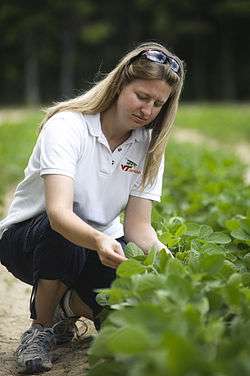Virginia Tech College of Agriculture and Life Sciences
 | |
| Motto | Ut Prosim (Latin) |
|---|---|
Motto in English | That I May Serve |
| Type | Public University |
| Established | 1903[1] |
| Dean | Alan Grant |
| Students | 3,290 |
| Undergraduates | 2,746 |
| Postgraduates | 544 |
| Location | Blacksburg, in Virginia, U.S. |
| Total Alumni | More than 21,000[2] |
| Colors | Chicago maroon and Burnt orange[3] |
| Affiliations | Virginia Tech |
| Website |
www |
 | |
The College of Agriculture and Life Sciences is one of eight colleges at Virginia Tech with a three-part mission of learning, discovery, and engagement and it is one of the best agriculture programs in the nation. It has more than 2,500 undergraduate and graduate students in a dozen academic departments.[4] In 2013, the National Science Foundation ranked Virginia Tech No. 6 in the country for agricultural research expenditures, much of which originated from the College of Agriculture and Life Sciences.[5]
As part of Virginia Tech’s land-grant mission, the college administers Virginia Cooperative Extension in partnership with Virginia State University.
Departments
The college is home to a dozen academic departments:
- Agricultural and Applied Economics[6]
- Agricultural, Leadership, and Community Education[7]
- Animal and Poultry Sciences[8]
- Biochemistry[9] (with the College of Science)
- Biological Systems Engineering (with the College of Engineering)[10]
- Crop and Soil Environmental Sciences[11]
- Dairy Science[12]
- Entomology[13]
- Food Science and Technology[14]
- Horticulture[15]
- Human Nutrition, Foods and Exercise[16]
- Plant Pathology, Physiology, and Weed Science[17]
History
| Andrew M. Soule | 1903–1906 |
| W.J. Quick | 1906–1908 |
| Harvey L. Price | 1908–1945 |
| Thomas B. Hutcheson | 1946–1950 |
| Leander B. Dietrick | 1952–1962 |
| Wilson B. Bell | 1962–1968 |
| James E. Martin | 1968–1975 |
| James R. Nichols | 1975–1991 |
| Andy L. Swiger | 1992–2003 |
| Sharron S. Quisenberry | 2003–2009 |
| Alan L. Grant | 2009–present |
Founded in 1872 as a land-grant college named Virginia Agricultural and Mechanical College, Virginia Tech has evolved into a large public university with numerous degree offerings. The College of Agriculture and Life Sciences provides the kind of education intended under the Morrill Act of 1862, making it the center of the land-grant tradition at Virginia Tech. Closely associated with the college are the Virginia Agricultural Experiment Station, established in 1886, and Virginia Cooperative Extension, established in 1914.[19]
Today, the College of Agriculture and Life Sciences has more than 21,000 alumni.[20]
Academics

The college offers bachelor's degrees in 13 majors as well as an undecided option.[21] The Agricultural Technology Program prepares students for careers in the agricultural and green industries with a concentrated, two-year degree experience that leads to an associate degree. Students specialize in either applied agricultural management or landscape and turf management.[22]
Research
The college's Research division has identified six program areas as a focus for development and investment.[23]
Together with the College of Natural Resources and Environment and the Virginia-Maryland Regional College of Veterinary Medicine, the college administers the Virginia Agricultural Experiment Station, which allows faculty to investigate food and fiber systems, their impact on the environment, and natural and human resource issues. Eleven agricultural research and Extension centers, which are dispersed throughout Virginia’s five geographical areas, support this research system.[24]
Virginia Tech’s research expenditures in the agricultural and life sciences have consistently ranked among the top in the nation. In 2009, these expenditures exceeded $91.6 million and accounted for more than 23 percent of Virginia Tech’s research spending.[25] Through research and Extension efforts, the college helped elevate the state’s agricultural exports to record numbers. In 2013, exports in the commonwealth reached $2.85 billion.[26]
See also
References
- ↑ "CALS History". vt.edu. 30 October 2015.
- ↑ "Alumni" (PDF). vt.edu.
- ↑ "The Brand Guide: Virginia Tech Identity Standards and Style Guide" (PDF). Virginia Tech. February 2015. p. 10. Retrieved November 4, 2015.
The burnt orange and Chicago maroon are the university's official colors that were adopted in 1896.
- ↑ "College Quick Facts - College of Agriculture and Life Sciences, Virginia Tech". Retrieved 2009-01-27.
- ↑ "Virginia Tech agricultural sciences programs rise in National Science Foundation rankings". Virginia Tech News. Virginia Tech. Retrieved 21 May 2015.
- ↑ http://www.aaec.vt.edu/
- ↑ http://www.alce.vt.edu/
- ↑ http://www.apsc.vt.edu/
- ↑ http://www.biochem.vt.edu/
- ↑ http://www.bse.vt.edu/
- ↑ http://www.cses.vt.edu/
- ↑ http://www.dasc.vt.edu/
- ↑ http://www.ento.vt.edu/
- ↑ http://www.fst.vt.edu/
- ↑ http://www.hort.vt.edu/
- ↑ http://www.hnfe.vt.edu/
- ↑ http://www.ppws.vt.edu/
- ↑ "College Deans - College of Agriculture and Life Sciences, Virginia Tech". Retrieved 2009-01-27.
- ↑ "History - College of Agriculture and Life Sciences, Virginia Tech". Retrieved 2009-01-27.
- ↑ "Alumni" (PDF). vt.edu.
- ↑ "New Academic Programs Available to Undergraduates". Retrieved 2011-05-24.
- ↑ "Areas of Interest (Options) - College of Agriculture and Life Sciences, Virginia Tech". Retrieved 2009-01-27.
- ↑ Greiner, Lori. "Transforming lives through learning, discovery, and engagement." Virginia Tech Magazine. Spring 2005. Pp. 22-23.
- ↑ "Agricultural Research and Extension Centers". Retrieved 2011-05-24.
- ↑ "National Science Foundation ranks Virginia Tech No. 5 for agricultural sciences". Retrieved 2011-05-24.
- ↑ CALS Research
